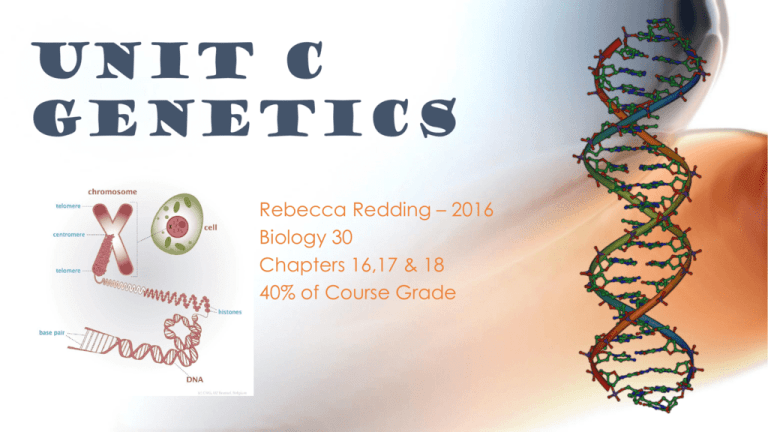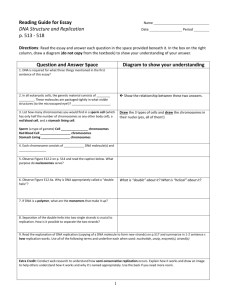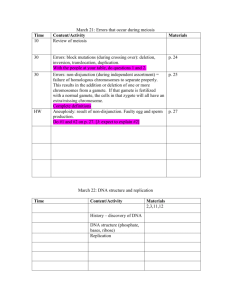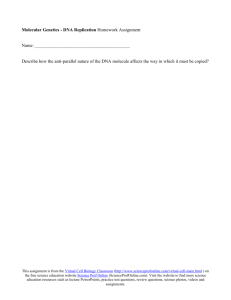Unit C Genetics - Ms. Redding's Science Page!
advertisement

Unit C Genetics Rebecca Redding – 2016 Biology 30 Chapters 16,17 & 18 40% of Course Grade Chapter 16 – Cellular Reproduction • 16.1 Cell Division • The Cell Cycle • 16.2 Reproduction in Somatic Cells • Mitosis • 16.3 The Formation of Gametes • Meiosis • 16.4 Reproductive Strategies 16.1 – The Cell Cycle • The life cycle of a cell – the cell cycle • Cells are small – why? • Original cells, parent cells, give rise to new, daughter, cells • Organization of Genetic Information: • DNA wound around histone proteins • Histones become tightly packed (chromatin) • Chromatin form loops and attach to a protein scaffold • The scaffold folds to further condense into chromosomes 16.1 – The Cell Cycle • Chromosomes carry genes, locations of specific genes are at a specific locus. • Different forms of the same gene are called alleles • Chromosome Number in Humans • 22 Pairs of Homologous Chromosomes • 1 Pair of Sex Chromosomes • Ploidy: Haploid (n), Diploid (2n), Triploid (3n)… 16.1 – The Cell Cycle • Karyotype 16.1 – The Cell Cycle • Stages of the Cell Cycle 1. Interphase • G1, S and G2 2. 3. 4. 5. Prophase Metaphase Anaphase Telophase Followed by Cytokinesis (cytoplasm division) Homework • Please re-read section 16.1 • Make notes or complete your booklet pages • Section 16.1 Review Questions • Questions 1-7 • Modelling a Karyotype Lab: Page 554 • Read ahead! 16.2 Reproduction In Somatic Cells • Why do cells use Mitosis? 1. Growth • Example: 2. Maintenance • Example: 3. Repair • Example: 16.2 Reproduction In Somatic Cells • Interphase: Growth and DNA Replication • Prophase: • • • • Chromatin condenses into chromosomes Nuclear membrane disappears Centrioles migrate Spindle fibres form • Metaphase: • Chromosomes are guided towards the equator by spindle fibres 16.2 Reproduction In Somatic Cells • Anaphase: • Centromeres split and sister chromatids are pulled apart • Spindle fibres shorten • Chromosomes gather at the poles • Telophase: • • • • Chromatids begin to unwind Spindle fibres break down Nuclear membrane reforms Cytokinesis occurs. 16.2 Reproduction In Somatic Cells Homework • Please re-read section 16.2 • Make notes or complete your booklet pages • Section 16.2 Review Questions • Questions 1-7 • Read ahead! 16.3 – The Formation of Gametes • Meiosis • Reductional division and recombination of genetic material • Occurs in the ovaries and testes • Split into two phases – MI and MII but only ONE interphase! • Similar to mitosis except for the formation of tetrads and crossing over. 16.3 – The Formation of Gametes • Interphase: Growth and DNA Replication • Prophase I: • • • • • Chromatin condenses into chromosomes Nuclear membrane disappears Centrioles migrate Spindle fibres form Homologous chromosomes begin to pair up (Tetrad) • Metaphase I: • Chromosomes (Tetrads) are guided towards the equator by spindle fibres • Recombination occurs 16.3 – The Formation of Gametes • Anaphase I: • Centromeres split and homologous chromosomes are pulled apart • Spindle fibres shorten • Chromosomes gather at the poles • Telophase I: • Some cells will move from anaphase I into MII, while others will go through telophase first • Chromatids begin to unwind • Spindle fibres break down • Nuclear membrane reforms • Cytokinesis occurs. 16.3 – The Formation of Gametes • Meiosis II • Still has prophase, metaphase, anaphase and telophase except that there is no recombination or additional replication of genetic material • This stage is reductional 16.3 – The Formation of Gametes • Sources of Genetic Recombination • Independent assortment • Pairs of chromosomes line up along the equator independent of other tetrads (there is no order) • Crossing Over • Non-sister chromatids exchange information 16.3 – The Formation of Gametes Nondisjunction • Occurs during anaphase I or II • Uneven separation of chromosomes • Can cause various genetic disorders or sometimes cause the embryo to abort – Page 567 16.3 – The Formation of Gametes Gamete formation in animals: Spermatogenesis • Diploid spermatogonium at puberty becomes two daughter cells. One replenishes the spermatogonia population and the other becomes a primary spermatocyte which undergoes meiosis to form spermatids 16.3 – The Formation of Gametes Oogenesis • Diploid oogonium undergoes division to form 2 primary oocytes • About three months after conception, about 2 million have formed. TheyOogenesis are arrested in prophase I until puberty. • Every month after puberty, a primary oocyte undergoes meiosis but cytoplasm is divided unevenly so only one secondary oocyte is formed as a result • Meiosis is not completed, but rather arrested in metaphase II until fertilization Homework • Please re-read section 16.3 • Make notes or complete your booklet pages • Section 16.3 Review Questions • Questions 1-10 • Model Mitosis and Meiosis – Draw them out. • Read ahead! • Quiz coming soon! 16.4 – Reproductive Strategies Reproduction in Prokaryotes • Binary fission • Not mitosis! No nucleus, growing and splitting • Bacterial Conjugation • • • • Primitive sexual reproduction Still asexual Transfer of genetic information through a pilus Minimal differentiation in genetic material 16.4 – Reproductive Strategies Asexual Reproduction • Budding • Miniature version grows from parents body • Vegetative Reproduction • Extending stems (runners) • Fragmentation • Broken off the parent plant and generates a new plant • Parthenogenesis • Unfertilized egg still develops into an adult • Spores • Good to move organisms great distances 16.4 – Reproductive Strategies Alternation of Generations Only in Plants • Haploid (gametophyte) and Diploid (sporophyte) generations • Mosses • Conifers 16.4 – Reproductive Strategies Alternation of Sexual Cycles • Occurs in animals • periods of alternating asexual and sexual producing phases • Eg – Cnidarian • Can be a polyp (asexual) or medusa (sexual) Homework • Please re-read section 16.4 • Make notes or complete your booklet pages • Section 16.4 Review Questions • Questions 1-9 • Read ahead! • Chapter Test coming soon! Chapter 17: Patterns and Processes of Inheritance • 17.1 Laying the Foundations • Intro to Genetics • 17.2 Mendel’s Laws • Patterns and Probabilities • 17.3 Genetics and Society • Pedigrees 17.1 – Laying the Foundations • Gregor Mendel 17.1 – Laying the Foundations • The Law of Segregation: individuals have two copies of every trait. These copies segregate during gamete formation, independently of one another. • Phenotype – observable • Genotypes – alleles for a particular trait • Homozygous – AA or aa • Heterozygous - Aa 17.1 – Laying the Foundations Test Cross • Used to determine the genetics on an animal with unknown genotype • Cross with homozygous recessive – Why? • Page 591 Qu 1&2 17.1 – Laying the Foundations • The Law of Independent Assortment: the two alleles for a trait will segregate independently from other alleles of other traits during gamete formation • Dihybrid Crosses 17.1 – Laying the Foundations • Incomplete dominance: • ‘blending’ • Co –dominance: • Both alleles visible • Punnett Square Notation is different since there is no recessive • Page 596 Qu 3-7 Homework • Please re-read section 17.1 • Make notes or complete your booklet pages • Section 17.1 Review Questions • Questions 1-12 • Read ahead! 17.2 – Extending Mendel’s Laws Linked Genes • Genes found on the same chromosome that do not assort independently • Genes that are close enough together on a chromosome may not assort independently because they cross over together • Led to chromosome mapping 17.2 – Extending Mendel’s Laws • Look at recombination frequency to determine gene linkage • Recombinants are offspring that don’t look like the parents – are a mix of both, usually. • Recombination frequency allows up to build a map as % recombination = map units 17.2 – Extending Mendel’s Laws • Page 602 Thought Lab 17.1 Mapping Chromosomes • I will start you off, you will complete the rest 17.2 – Extending Mendel’s Laws Barr Bodies • Inactive chromosome – like the second X chromosome in women. • Which chromosome forms a barr body is random • Ex: Tortishell Cats – why are male cats so rare? 17.2 – Extending Mendel’s Laws • Multiple Alleles: Usually an order of dominance, but can be co-dominant or a mixture! • Ex: ABO blood types • Ex: Fur colour in rabbits • Polygenic Inheritance: controlled by many genes and result in a spectrum of phenotypes • Ex: human height Page 606 Qu 11-17 Homework • Please re-read section 17.2 • Make notes or complete your booklet pages • Finish the 17.1 Thought Lab • Section 17.2 Review Questions • Questions 1-6 • Read ahead! 17.3 – Genetics and Society Pedigrees – factors to consider • Is the trait located on a sex chromosome or an autosome? • Autosomal – not on a sex chromosome • Sex Linkage – located on one of the sex chromosomes • Y-linked - only males carry the trait. • X-linked (recessive) - sons inherit the disease from normal parents • How is the trait expressed? • Dominant - the trait is expressed in every generation. • Recessive - expression of the trait may skip generations. 17.3 – Genetics and Society • Page 612 – Pedigree Symbols • Autosomal Dominant • Shows up in every generation • Both sexes equally affected • Autosomal Recessive • Skips generations • Both sexes equally affected • Sex Linked • Sexes are not affected equally • Sample Problem Page 614 • Practice Page 615 Qu 18-21 Homework • Please re-read section 17.3 • Make notes or complete your booklet pages • Complete the 17.2 Thought Lab (Partners) • Complete the 17.3 Thought Lab (Alone) • Section 17.3 Review Questions • Questions 1-5 • Read ahead! • Chapter Test Coming up! Chapter 18 – Molecular Genetics • 18.1 DNA structure • DNA replication • 18.2 Protein Synthesis • Transcription and translation of DNA • 18.3 Mutation and Recombination • Permanent changes to DNA • 18.4 Genetics and Society 18.1 – DNA Structure and Replication • Isolating the material of heredity – the transforming principle (Griffith) • Showed that when DNA could transform • Heat killed virulent bacteria could transform non-virulent strains 18.1 – DNA Structure and Replication Hershey and Chase • T2 bacteriophages were labelled with sulfur and phosphorous. • Monitored how the virus spread. • The phosphorus ended up in with the DNA and the sulfur was found outside in the protein coat • Proved DNA was responsible for directing the cells. 18.1 – DNA Structure and Replication • Double helix structure discovered in 1950’s by Rosalind Franklin • Chargaff – proposed that certain proportions of nucleotides were similar to one another. • Adenine – Thymine • Cytosine – Guanine • DNA forms an antiparallel structure with its phosphate and sugar back bone 18.1 – DNA Structure and Replication • RNA is similar to DNA but has a couple of differences • Ribose instead of deoxyribose • Uracil instead of Thymine • Single stranded 18.1 – DNA Structure and Replication • DNA Replication – semiconservative • Initiation • Starts at the origin • Helicase unwinds the DNA • Creates a replication fork or ‘bubble’ • Elongation • • • • • • DNA polymerase begins to add nucleotides Occurs in the 5’-3’ direction Creates a leading and lagging strand Elongation is helped with a primer Okazaki fragments result on the lagging strand Sealed together with ligase • Termination 18.1 – DNA Structure and Replication Homework • Please re-read section 18.1 • Make notes or complete your booklet pages • Section 18.1 Review Questions • Questions 1-10 • Read ahead! 18.2 – Protein Synthesis & Gene Expression Central Dogma • DNA RNA Protein • Transcription takes place in the nucleus and involves mRNA • mRNA moves to the cytoplasm where the mRNA sequence directs the synthesis of a polypeptide along with tRNA (Translation) 18.2 – Protein Synthesis & Gene Expression • The genetic code • Redundant • Continuous • Universal • Practice Problems: Page 637 Qu 3-5 • Practice Problems: Page 638 Qu 6&7 Homework • Please re-read section 18.2 • Make notes or complete your booklet pages • Snorks Assignment • Section 18.2 Review Questions • Questions 1-10 • Read ahead! 18.3 – Mutation and Recombination • What is a mutation? • What causes mutations? Types of Mutations: • Point mutations • Silent mutations • Mis-sense mutations • Non-sense mutations • Frameshift mutations 18.3 – Mutation and Recombination Causes of Mutations • Spontaneous –incorrect base pairing • Induced – triggered or caused by a mutagen • Physical: X Rays, UV Rays (cause physical changes to the DNA structure) • Chemical: Carcinogens, gasoline fumes, nitrates etc… (can enter the nucleus and react chemically with the DNA to cause mutations) 18.3 – Mutation and Recombination What is mtDNA? • Found in the mitochondria • Passed on through females – why? • Can help us trace our ancestory 18.3 – Mutation and Recombination • Recombinant DNA • Use restriction endonucleases to cleave sequences (restriction fragments) and splice DNA • Giving animals and plants characteristics or qualities that they didn’t originally have 18.3 – Mutation and Recombination • Gel Electrophoresis: Video Demo Homework • Please re-read section 18.3 • Make notes or complete your booklet pages • Section 18.3 Review Questions • Questions 1-7 • Read ahead! 18.4 – Genetics and Society What is a DNA Microarray? • A chip that contains thousands of cells. Each cell contains a nucleic acid sequence that can bind with one of the mRNA transcribed during gene expression • Once DNA is added to the microarray, it will be scanned and a specific pattern will emerge, allowing us to see what genes are contained within the genome we are studying. 18.4 – Genetics and Society Biotechnology Products – Thoughts? • Medicinal Bacteria • Synthetic Insulin • Transgenic Plants • Plants modified to create resistance to pesticides • Cloned and Transgenic Animals • ‘Dolly’, identical twins 18.4 – Genetics and Society • Diagnosis and Treatment of Genetic Disorders • Amniocentesis • Amniotic fluid is draw out of the expecting mother and tested • A karyotype is prepared and analysed • Chorionic villi sampling • Can happen sooner than Amniocentesis – 9 weeks • Taken from the chorion (part of the placental tissues) Homework • Please re-read section 18.4 • Make notes or complete your booklet pages • Section 18.4 Review Questions • Questions 1-7 • Chapter Test coming soon • Unit Review - Start • Unit Exam coming soon!





